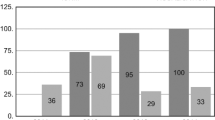Abstract
Background - Aim
The role of intraoperative neuromonitoring (IONM) of the recurrent laryngeal nerve (RLN) in thyroid surgery remains controversial. We present herein the initial experience in the use of the IONM of the RLN in our Department. The objective of the present study was to determine the potential role of IONM in reducing postoperative RLN palsy rate
Methods
Between June 1996 and August 2010, 696 patients underwent total thyroidectomy due to benign or malignant conditions of the thyroid gland. From January 2008 to August 2010, IONM of the RLN was applied in 84 of these patients in order to identify and preserve the RLNs, whereas conventional RLN identification was used in the remaining 612 patients.
Results
Eighty four total thyroidectomies and two reoperations were performed using IONM of the RLN with 170 nerves at risk and 612 total thyroidectomies and 38 re-operations with 1262 nerves at risk were performed by routine identification. The incidence of transient and permanent RLN paralysis based on nerves at risk was 0.59% (1 of 170) and 0% (0/170) with intraoperative neuromonitoring and 0.24% (3 of 1262) and 0% (0/1262) with conventional RLN identification.
Conclusion
Neuromonitoring of the RLN during thyroid surgery could not be demonstrated to reduce RLN injury significantly, compared with routine RLN identification. Nevertheless, its application can be considered in selected high-risk thyroidectomies. This technological process may render safer thyroidectomies performed by junior surgeons or surgeons with low case-load.
Similar content being viewed by others
References
Kern KA. Medicolegal analysis of errors in diagnosis and treatment of surgical endocrine disease. Surgery 1993;114:1167–1173; discussion 1173–1164
Rubin AD, Sataloff RT. Vocal fold paresis and paralysis: what the thyroid surgeon should know. Surg Oncol Clin N Am 2008;17(1):175–196
Harness JK, Fung L, Thompson NW et al Total thyroidectomy: complications and technique. World J Surg 1986;10:781–786
Karlan MS, Catz B, Dunkelman D et al A safe technique for thyroidectomy with complete nerve dissection and parathyroid preservation. Head Neck Surg 1984;6:1014–1019
Jatzko GR, Lisborg PH, Muller MG et al Recurrent nerve palsy after thyroid operations—principal nerve identification and a literature review. Surgery 1994;115:139–144
Steurer M, Passler C, Denk DM et al Advantages of recurrent laryngeal nerve identification in thyroidectomy and parathyroidectomy and the importance of preoperative and postoperative laryngoscopic examination in more than 1000 nerves at risk. Laryngoscope 2002;112:124–133
Chiang FY, Wang LF, Huang YF et al Recurrent laryngeal nerve palsy after thyroidectomy with routine identification of the recurrent laryngeal nerve. Surgery 2005;137:342–347
Snyder SK, Lairmore TC, Hendricks JC et al Elucidating mechanisms of recurrent laryngeal nerve injury during thyroidectomy and parathyroidectomy. J Am Coll Surg 2008; 206:123–130
Randolph GW. Surgical anatomy of the recurrent laryngeal nerve. In: Randolph GW, ed. Surgery of the Thyroid and Parathyroid Glands. Philadelphia, PA: Elsevier Science; 2002:300–342.
Dralle H, Sekulla C, Haerting J, et al. Risk factors of paralysis and functional outcome after recurrent laryngeal nerve monitoring in thyroid surgery. Surgery 2004;136:1310–1322.
Eisele DW. Intraoperative electrophysiological monitoring of the recurrent laryngeal nerve. Laryngoscope. 1996;106:443–449.
Otto RA, Cochran C. Sensitivity and specificity of intraoperative recurrent laryngeal nerve stimulation in predicting postoperative nerve paralysis. Ann Otol Rhinol Laryngol. 2002;111:1005–1007.
Marcus B, Edwards B, Yoos S, et al. Recurrent laryngeal nerve monitoring in thyroid and parathyroid surgery: The University of Michigan Experience. Laryngoscope 2003;113:356–361.
Song P, Shemen L. Electrophysiologic laryngeal nerve monitoring in high-risk thyroid surgery. Ear Nose Throat J 2005;84:378–381.
Richmond BK, Eads K, Flaherty S, Belcher M, Runyon D. Complications of thyroidectomy and parathyroidectomy in the rural community hospital setting. Am Surg 2007;73(4):332–336.
Dralle H, Sekulla C, Lorenz K, Brauckhoff M, Machens A. Intraoperative monitoring of the recurrent laryngeal nerve in thyrois surgery. World J Surg 2008;32(7):1358–1366.
Thomusch O, Sekulla C, Walls G, Machens A, Dralle H. Intraoperative neuromonitoring of surgery for benign goiter. Am J Surg 2002;183:673–678.
Hermann M, Alk G, Roka R, Glaser K, Freissmuth M. Laryngeal recurrent nerve injury in surgery for benign thyroid diseases: effect of nerve dissection and impact of individual surgeon in more than 27,000 nerves at risk. Ann Surg 2002;235:261–268
Robertson ML, Steward DL, Gluckmann JL, Welge J. Continuous laryngeal nerve integrity monitoring during thyroidectomy: does it reduce risk of injury? Otolaryngol Head Neck Surg 2004;131:596–600.
Beldi G, Kinsbergen T, Schlumpf R. Evaluation of nerve monitoring in thyroid surgery. World J Surg 2004;28:589–591
Chan WF, Lang BH, Lo CY. The role of intraoperative neuromonitoring of recurrent laryngeal nerve during thyroidectomy: a comparative study on 1000 nerves at risk. Surgery 2006;140(6):866–872
Barczynski M, Konturek A, Cichon S. Randomized clinical trial of visualization versus neuromonitoring of recurrent laryngeal nerves during thyroidectomy. Br J Surg 2009;96(3):240–246
Sturgeon C, Sturgeon T, Angelos P. Neuromonitoring in thyroid surgery: attitudes, usage patterns, and predictors of use among endocrine surgeons. World J Surg. 2009;33(3):417–425.
References
Dralle H, Sekulla C, Haerting J et al. Risk factors of paralysis and functional outcome after recurrent laryngeal nerve monitoring in thyroid surgery. Surgery 2004;136:1310–1322.
Higgins TS, Gupta R, Ketcham AS et al. Recurrent laryngeal nerve monitoring versus identification alone on post-thyroidectomy true vocal fold palsy: A meta-analysis. The Laryngoscope 2011;121(5):1009–1017.
Electrophysiologic Recurrent Laryngeal Nerve Monitoring During Thyroid and Parathyroid Surgery: International Standards Guideline Statement. The Laryngoscope 2010;121:S1–S16.
Author information
Authors and Affiliations
Corresponding author
Rights and permissions
About this article
Cite this article
Georgiadou, D., Perysinakis, I., Spyridakis, J. et al. Intraoperative neuromonitoring of recurrent laryngeal nerve: Initial experience. Hellenic J Surg 83, 115–120 (2011). https://doi.org/10.1007/s13126-011-0021-6
Received:
Accepted:
Published:
Issue Date:
DOI: https://doi.org/10.1007/s13126-011-0021-6



